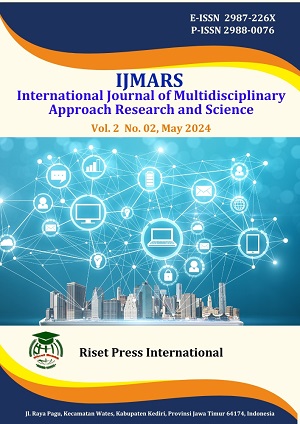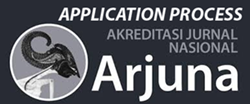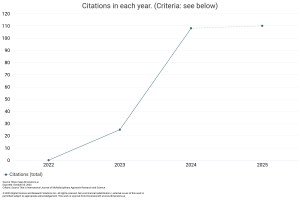Gratitude for Teenagers with Disabilities (Physical Disability)
DOI:
https://doi.org/10.59653/ijmars.v2i02.654Keywords:
Gratitude, Teenagers, DisabilitiesAbstract
The purpose of this study is to describe gratitude in teenagers with disabilities (physical disability). This type of research is qualitative with a phenomenological approach. The subjects are adolescents who are physically disabled. The results obtained show that gratitude is a feeling and attitude of accepting everything that has been given by God, by trying to return everything to God. Factors that influence the gratitude of adolescents with disabilities are faith in God, the presence of parents, social support (friends, parents, and living environment), religious experience. Meanwhile, the benefits obtained from the feeling of gratitude are physical health, increased ability of self-esteem, not easily despairing, living life without burden and being more patient.
Downloads
References
Al-Jauziyyah, I. Q. (2010). Sabar dan Syukur: Menguak Rahasia di Balik Keutamaan Sabar dan Syukur. Semarang: Pustaka Nuun.
Al-Munajjid, M. B. S. (2006). Silisilah Amalan Hati: Ikhlas, Tawakkal, Optimis, Takut, Bersyukur, Ridha, Sabar, Introspeksi Diri, Tafakkur, Mahabbah, Taqwa, Wara’. Bandung: Irsyad Baitus Salam.
Astria, N. (2021). Pendidikan Sabar dan Syukur dalam QS. AL Baqarah Ayat 152- 153 dan QS. Ibrahim Ayat 5-7.
Emmons, R. A., & McCullough, M. E. (2003). Counting blessings versus burdens: An experimental investigation of gratitude and subjective well-being in daily life. Journal of Personality and Social Psychology, 84, 377–389.
Dewanto W & Retnowati. (2015). Intervensi Kebersyukuran dan Kesejahteraan Penyandang Disabilitas Fisik. Gadjah Mada Journal Of Profesional Psychology, Vol 1 (1), 33-47.
Froh, J. J. (2004). The History of Positive Psychology: Truth Be Told. The Psychologist, 16 (3), 18-20.
Kementrian Sosial Republik Indonesia. (2020). Kemensos Dorong Aksesibilitas Informasi Ramah Penyandang Disabilitas.
Linley, P. A., Joseph, S., Harrington, S. & Wood, A. M. 2006. Positive psychology: Past, present, and (possible) future. The Journal of Positive Psychology, 1(1), 3–16.
Miller, L. Bansal, R., Wikramaratne, P., Hao, X., Tenke, C. E., Weissman, M. M., & Patterson, B. S. (2013). Neuroanatomical Correlates of Religiousity and Spiri- tuality; A Study in Adults At High and Low Familial Risk for Depression. JAMA Psychiatry. http://dx.doi.org/10.101.jamapsychiatry.2013.3067
Muhibbuddin, M. (2019). Terapi & Muhasabah Hati. Yogyakarta: Mueeza.
Putri, AR. (2023). Kebersyukuran pada Penyandang Disabilitas Fisik Muslim di Sragen. (Skripsi, Fakultas Ushuluddin dan Dakwah, Universitas Islam Negeri Raden Mas Said Surakarta: Surakarta) diakses dari http://eprints.iain-surakarta.ac.id/3536/1/Full%20Teks_181131007.pdf
Putri, D. W. L., & Rosiana, I. (2017). Kebersyukuran pada penyandang cacat di Yogyakarta. Al-Tazkiah: Jurnal Bimbingan Dan Konseling Islam, 6(2), 82– 94.
Subandi. (2011). 130454-ID-sabar-sebuah-konsep-psikologi. Fakultas Psikologi, 98 Universitas Gadjah Mada, 38(2), 215–227.
Sugiyono. (2015). Metode Penelitian Kuantitatif, Kualitatif dan R&D. Bandung: ALFABETA.
Tumanggor, YP., dkk. (2020). Psychological Well-Being reviewed from Mindfulness In Adolescents Disability in NPC Province North Sumatera. J-P3K: Vol. 2 (2), pg. 102-106. https://www.jurnalp3k.com/index.php/J-P3K/article/view/86/pdf
Watkins, P. C., Woodward, K., Stone, T., & Kolts, R. L. (2003). Gratitude and happiness: Development of a measure of gratitude, and relationships with subjective wellbeing.. Social Behavior and Personality, 31, 431–451.
Wood, A. M., Joseph, S., & Linley, P. A. (2007). Coping Style As A Psychological Resource of Grateful People. Journal of Social and Clinical Psychology, 26(9) 1076–1093.
Downloads
Published
How to Cite
Issue
Section
Categories
License
Copyright (c) 2024 Rukiana Novianti Putri, Bahrul Amsal

This work is licensed under a Creative Commons Attribution-ShareAlike 4.0 International License.
Authors who publish with this journal agree to the following terms:
- Authors retain copyright and grant the journal right of first publication with the work simultaneously licensed under a Creative Commons Attribution-ShareAlike that allows others to share the work with an acknowledgement of the work's authorship and initial publication in this journal.
- Authors are able to enter into separate, additional contractual arrangements for the non-exclusive distribution of the journal's published version of the work (e.g., post it to an institutional repository or publish it in a book), with an acknowledgement of its initial publication in this journal.
- Authors are permitted and encouraged to post their work online (e.g., in institutional repositories or on their website) prior to and during the submission process, as it can lead to productive exchanges, as well as earlier and greater citation of published work (See The Effect of Open Access).
























